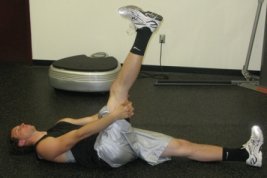Do you always wonder why you stretch and can’t seem to see results? Keep wondering what you’re doing wrong? You may be buying into some old myths that are keeping you from getting the most out of your flexibility training.
Myth #1 – Stretching before exercise will help you avoid injury.
There is actually very little scientific research to support the notion that stretching prior to exercise will help you avoid injury. Flexibility is important for reducing injury, but there is nothing to the myth that it should be performed prior to exercise. Actually, performing static stretching prior to speed and power sports has actually been shown to decrease athletic performance during your event. A good dynamic mobility warm-up will prepare your body for activity without decreasing performance. Stretching after exercise is the best time to increase flexibility.
Myth #2 – Stretching increases the length of a muscle.
This is a myth that can be hard to understand, because most of us were taught in school that to increase flexibility we needed to make our muscles “longer.” The fact is, muscle is muscle. What we mean by that is, all skeletal muscle is pretty much the same. What separates those with “tight” muscles from those who are flexible is their nervous system. The nervous system is the “software” of the body which controls every action. If your nervous system is hyperactive and sensitive, you will have a tendency to be tight. If it is less sensitive and tolerates stretching, you will not have flexibility problems. Instead of trying to lengthen your muscles, perform exercises which overload the nervous system and increase stretch tolerance.
Myth #3 – Most people don’t hold stretches long enough. In order to increase flexibility, you need to hold stretches 30-90 seconds.
As we explained in the Myth #2, we are not trying to increase muscle length; rather, increasing stretch tolerance is the key to increasing range of motion. Most of the older research which supports the use of longer stretches in order to completely relax the muscle, subscribes to the methodology that you need to increase muscle length to improve flexibility. The problem with this research is that all if the flexibility gains made in this manner have been proven to be lost within 1 hour.
In order to effectively increase stretch tolerance, perform cyclic stretching. Cyclic stretching is performed by holding stretches for 3-5 seconds and repeating 10-15 times.
Myth #4 – Static stretching is the most effective way to increase flexibility.
Static stretching is traditional performed by gently passively moving a limb until you feel a light stretching sensation in a muscle. This is done by using gravity or a partner to help you. This method can gain range of motion, but research shows that active stretches are a better alternative. These types of stretches usually incorporate a technique call reciprocal inhibition. Reciprocal inhibition states that when one muscle is contracted, the
These types of stretches usually incorporate a technique call reciprocal inhibition. Reciprocal inhibition states that when one muscle is contracted, the opposite muscle is relaxed; the greater the contraction, the greater the relaxation. Once the muscle is relaxed, it becomes easier to overload the nervous system and increase stretch tolerance.
opposite muscle is relaxed; the greater the contraction, the greater the relaxation. Once the muscle is relaxed, it becomes easier to overload the nervous system and increase stretch tolerance.
As an example, a great way to actively stretch the hamstrings is by lying on your back and grabbing behind your knee with both hands. Contract your quad to straighten your knee until you feel a hamstring stretch. Contracting your quads allows your hamstrings to relax and placing your hamstrings on stretch.
Myth #5 – When stretching a muscle, stop when you feel a light discomfort.
Research now shows that if you want to improve stretch tolerance, you need to take the stretch to a point of pain. This is not to say that you need to be in tears, gritting your teeth through every stretch. But, what it means is that if you don’t take a stretch to a point of pain, you are not likely overloading your nervous system well enough to improve stretch tolerance.

